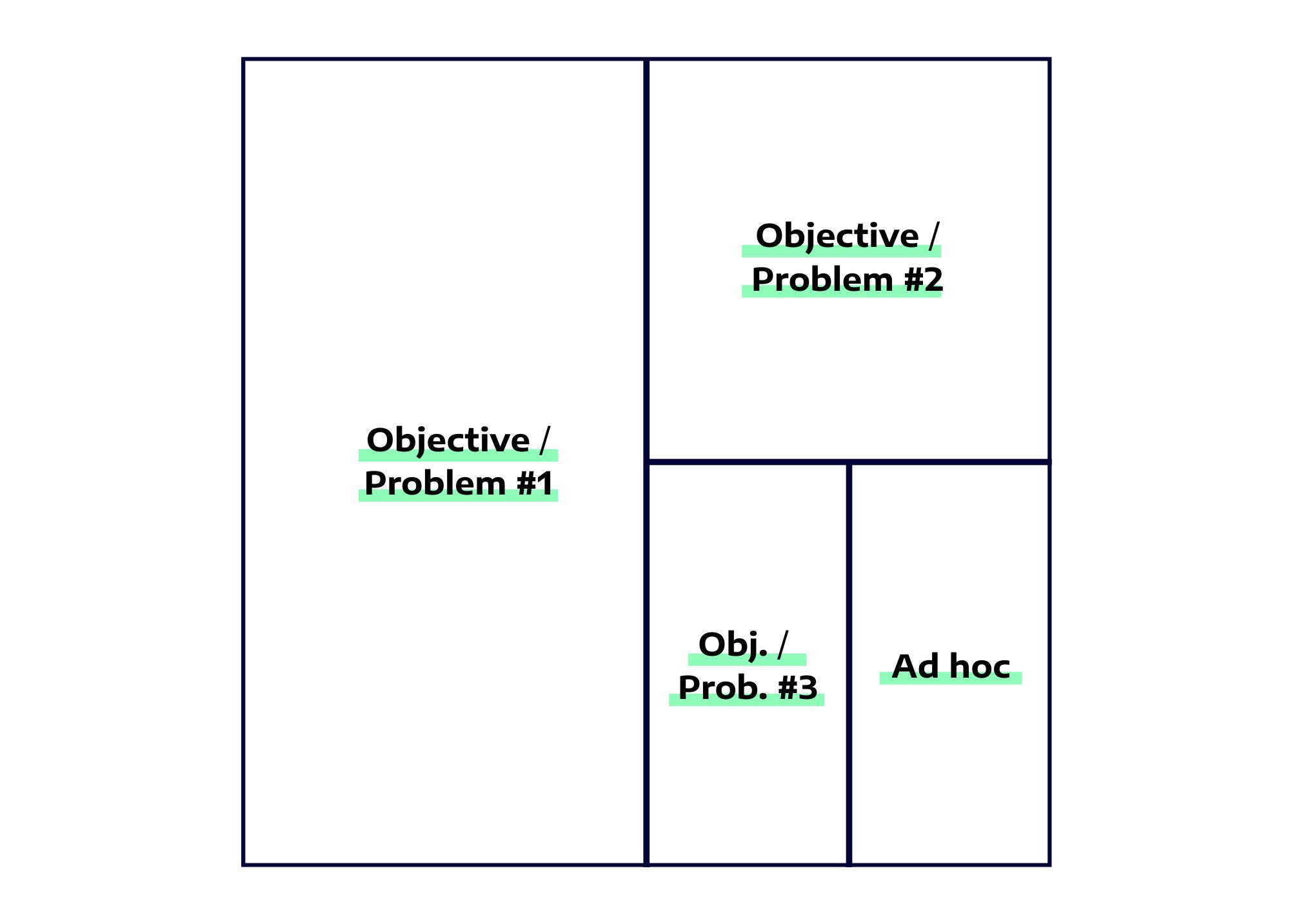Time and energy are the scarcest resources in high-performing product teams. How we prioritise what to build directly shapes the kind of value we deliver and how quickly we achieve it.
Yet many teams still fall into one of two traps:
- Taking on too many things at once
- Or constantly reacting to urgent requests instead of delivering against meaningful problems.
At dualoop, we use a lightweight prioritisation quadrant that helps teams focus on what matters while remaining flexible for the unexpected.
This article introduces the model and explains how to apply it at the team level to improve focus, delivery speed, and alignment with strategy.
From roadmaps to quadrants: reframing team prioritisation
Most companies still plan work using feature roadmaps or loosely defined quarterly OKRs. However, these often lack clarity on how much attention each initiative deserves and how to keep the team's attention undivided across quarters.
That’s why we recommend a fractal prioritisation quadrant, a repeatable structure that clarifies effort allocation at every level of the organisation.
It’s built on the idea that teams should focus on solving three problems at a time, not shipping ten features, and that problems don’t all deserve equal attention.
At its core, the quadrant assumes:
- Each team is assigned up to 3 key initiatives per quarter.
- These initiatives are defined as problems to solve, not features to deliver
- Each initiative receives a different share of team attention (1/2, 1/4, 1/8)
- The remaining ~12.5% of capacity is left for ad hoc needs or business reactivity.
💬 “The goal isn’t perfect planning. It’s to give teams focus, guardrails, and the space to react without derailing everything else.”
Visualising the quadrant

We believe in this distribution because teams need:
- Focus on the most critical challenge
- Room to explore secondary bets
- A realistic buffer for unplanned needs
The quadrant is not a planning tool, it’s a decision-making tool. It doesn’t tell you what to build, but how to focus.
The fractal principle: scale it across the org
This model is fractal; it can be used at multiple levels in the organisation:
- At the team level, to divide focus across initiatives
- At the initiative level, to break work into substreams.
- Even at the company level, with exec teams tracking strategic bets with similar ratios
When everyone applies the same logic to prioritisation, from product trios to leadership teams:
✅ Consistent structure
✅ Local ownership
✅ Global alignment
Prioritisation by initiative (not feature)
One of the key shifts is thinking in terms of initiatives, not feature outputs.
Each initiative should be:
- Framed as a problem to solve
- Prioritised based on expected business impact.
- Sized and sliced based on available attention bandwidth.
💡 If your company uses OKRs, initiatives can map to Objectives and break down further into Key Results.
Engineering allocation
The quadrant assumes that 80% of engineering capacity is used for initiatives.
The remaining 20% is intentionally left for:
- Technical excellence (e.g., refactoring, tests, design debt)
- Maintenance and bug fixing
- Developer-driven improvements
🛠️ Engineers, not product managers, own bug fixes. PMs should not need to triage production incidents unless they relate to product risk or experience. This split creates space for sustainable speed. It also signals that code quality and system health aren’t afterthoughts.
Team structure and scope
To make the quadrant work, team configuration matters:
- Teams must be stable, not formed around scopes
- Each team owns a clear product area (or flow)
- Cross-team overlaps should be avoided where possible
- Full-stack, autonomous product trios (PM, PD, Tech Lead) are standard
This is why dualoop encourages full-stack, stable trios, with PMs, designers, and engineers working together across cycles.
Why this works
This prioritisation model is deceptively simple but incredibly powerful when applied consistently.
Here’s why:
How to apply it
Here’s a lightweight flow to implement the model:
Quarterly
- Define or revisit the 3 top problems
- Map initiatives into 1/2, 1/4, 1/8 format
- Allocate engineering & design attention
- Leave 1/8 buffer
Monthly
- Review progress and reprioritise if needed
Sprint rituals
- Use the quadrant as input to planning
- Make trade-offs explicit (focus vs reactivity)
Visibility
- Display the quadrant in team rituals or docs
- Tie it to OKRs or product strategy
💬 “When everyone understands the trade-offs, teams stop fighting over priorities and start solving what matters.”
Final thoughts
Prioritisation isn’t a spreadsheet exercise. It’s about helping teams make better decisions, faster and giving them the mental clarity to focus on meaningful outcomes.
This quadrant empowers product teams with structure, not rigidity.
Used correctly, it can unlock better autonomy, fewer dependencies, and a sharper connection to company goals.
Want to go deeper?
- How to structure product trios for success
- The product execution flow explained
- The case for strategic alignment
